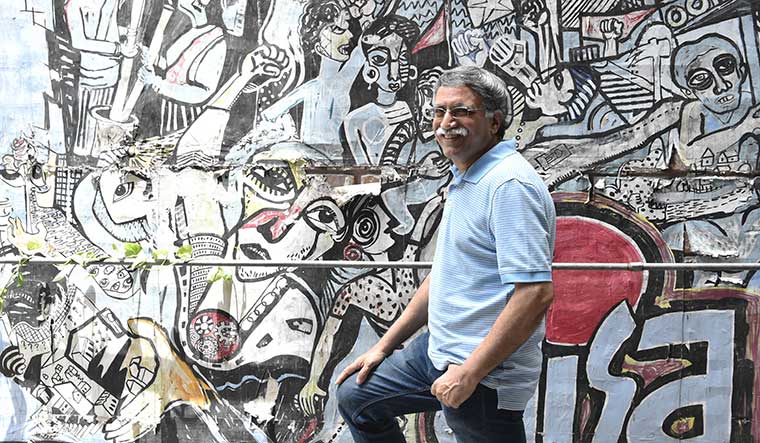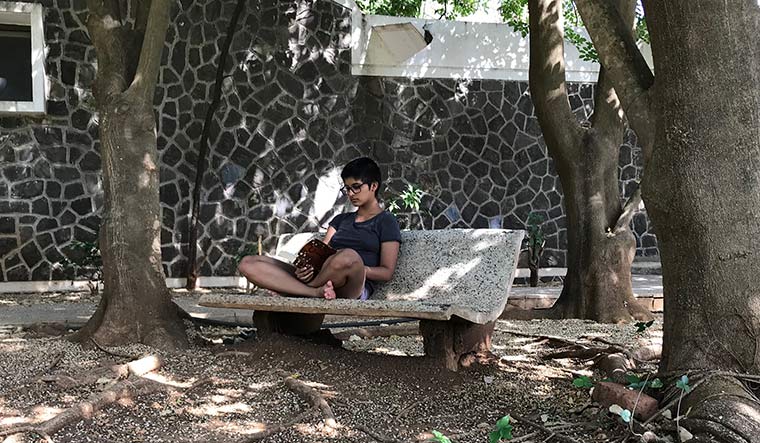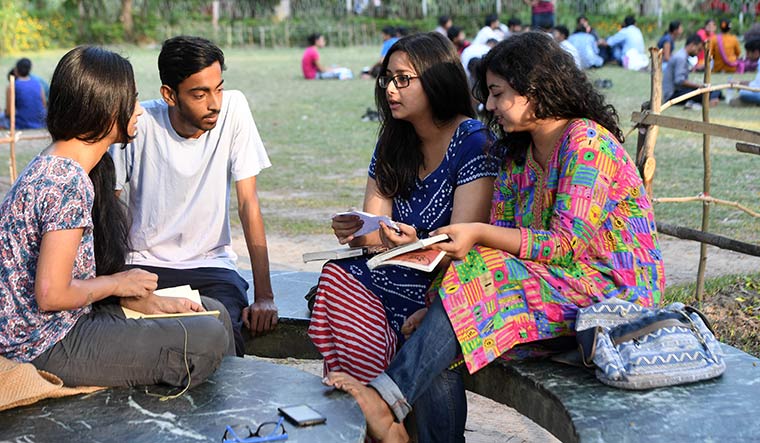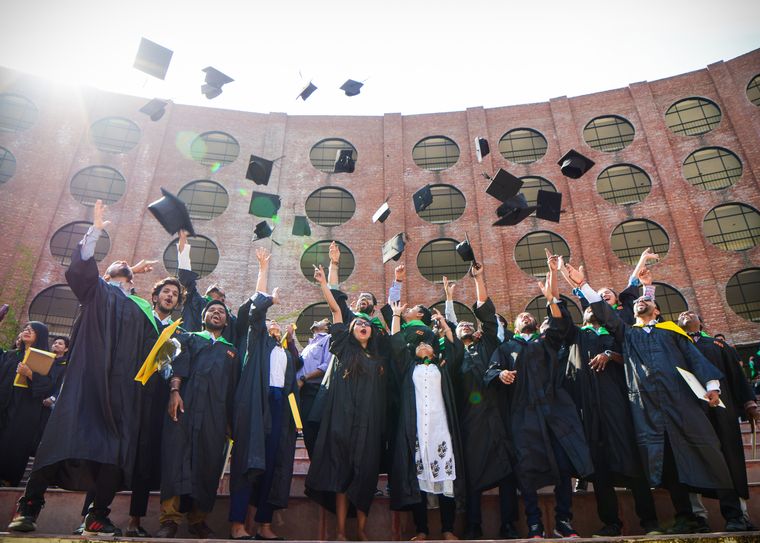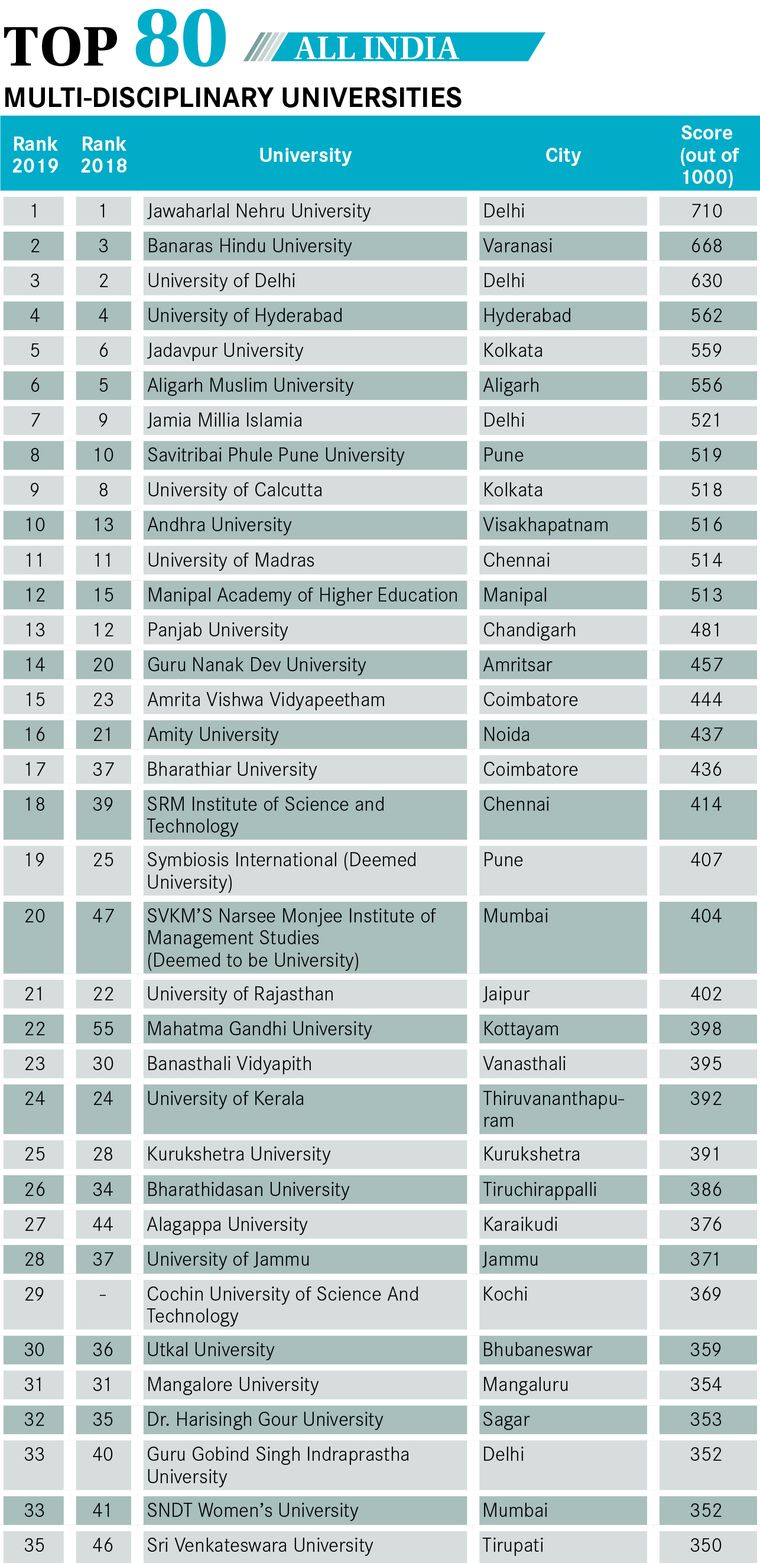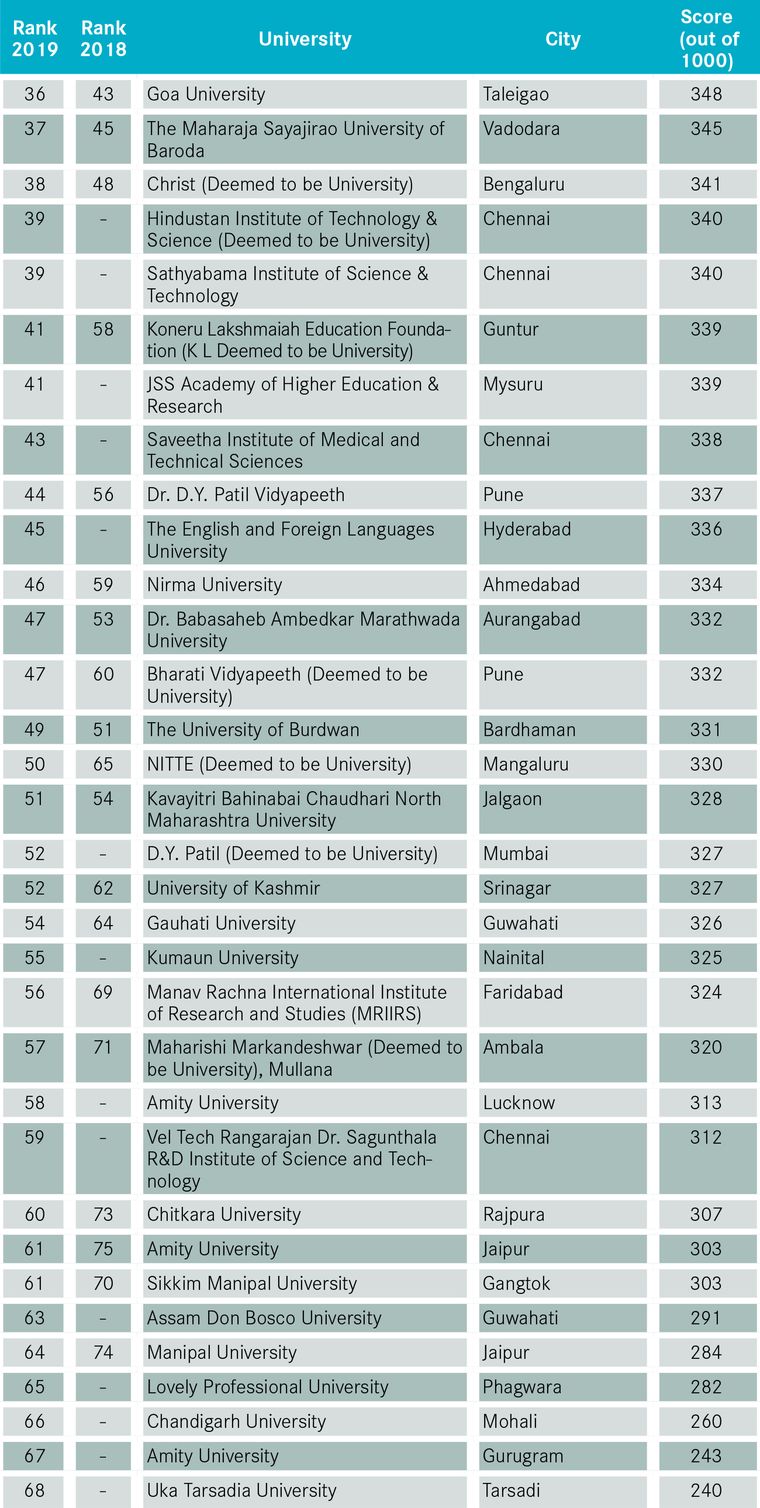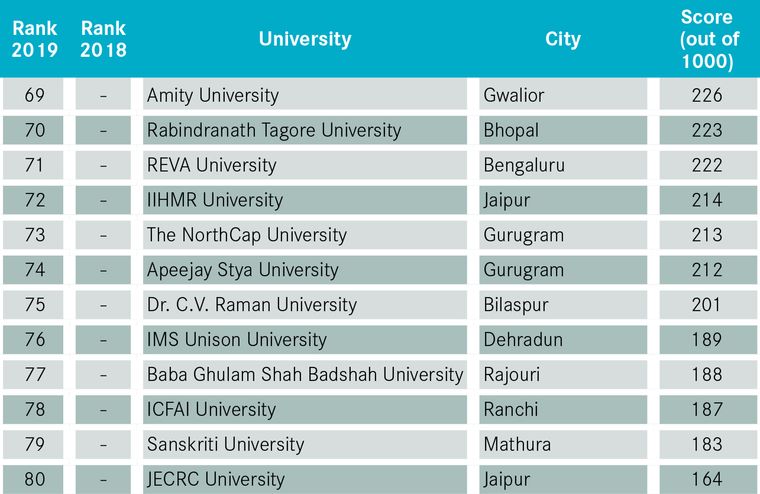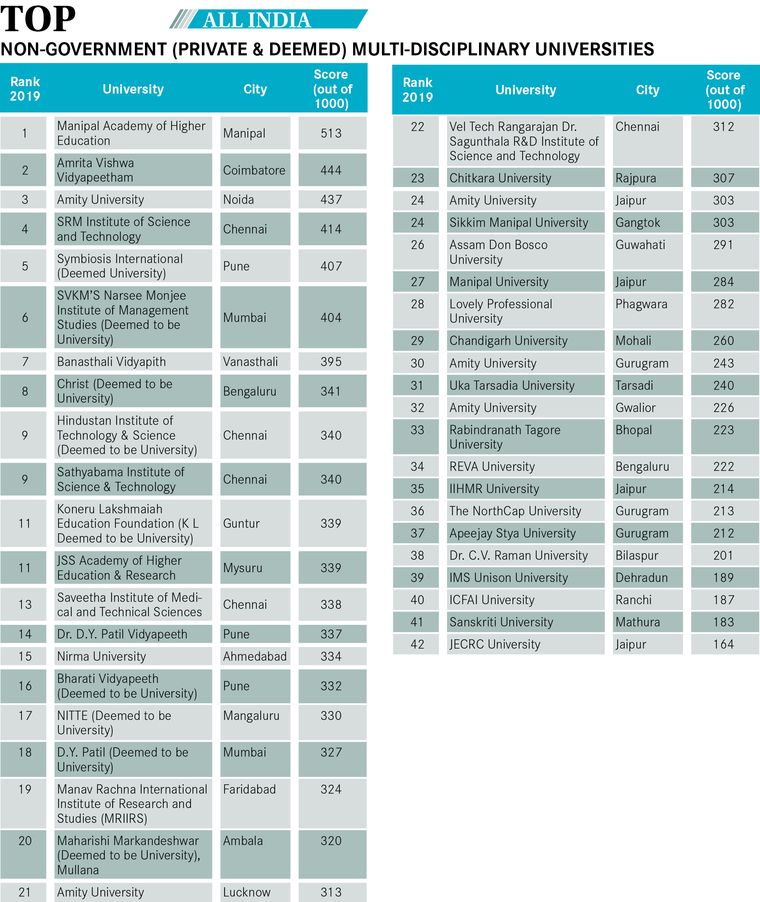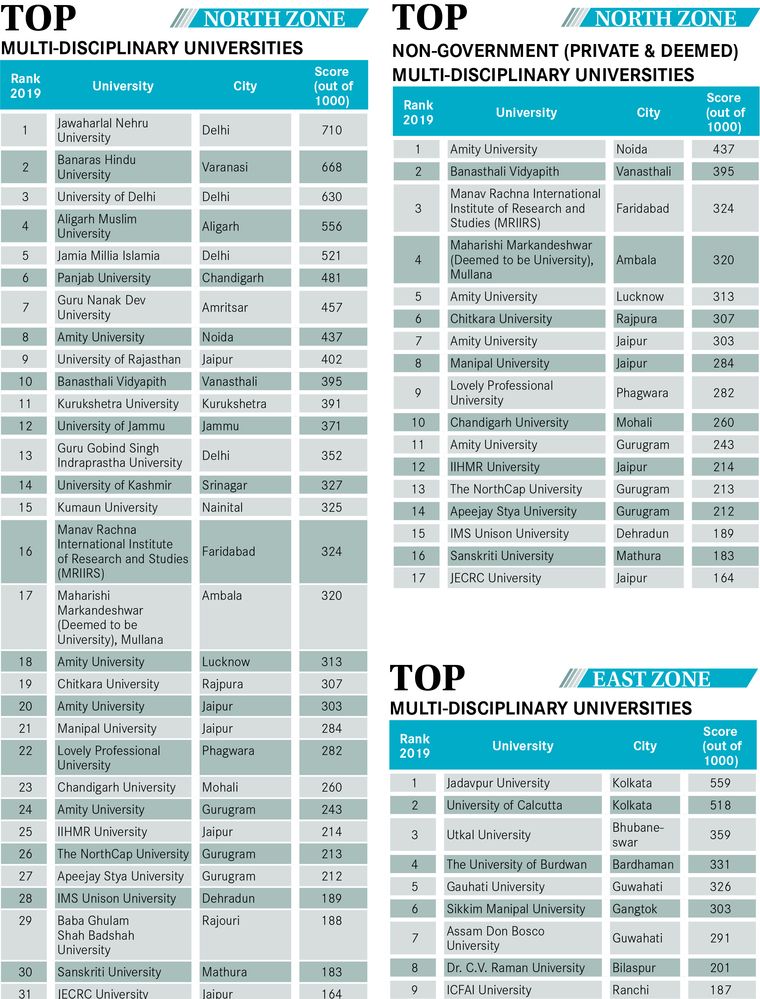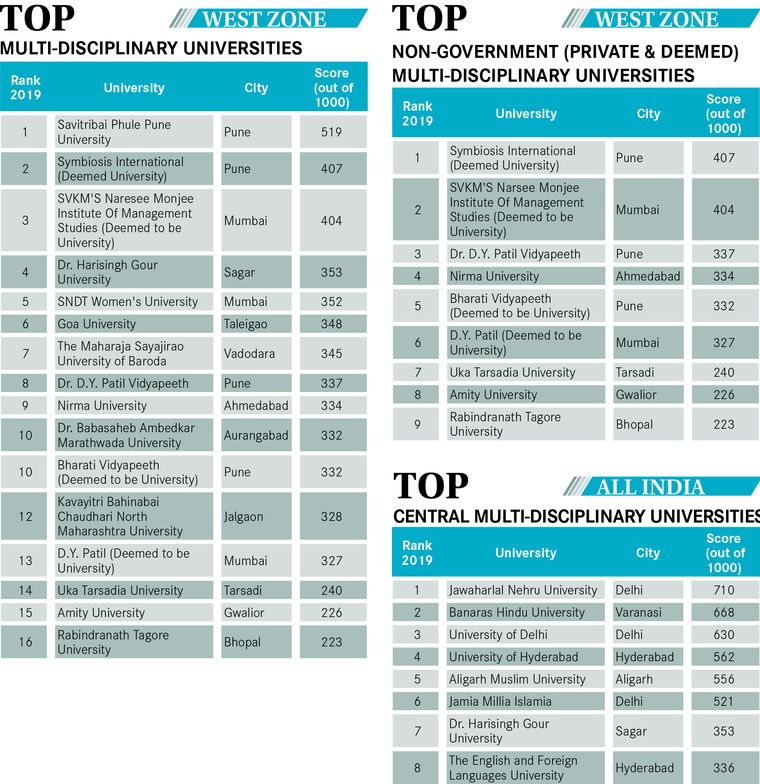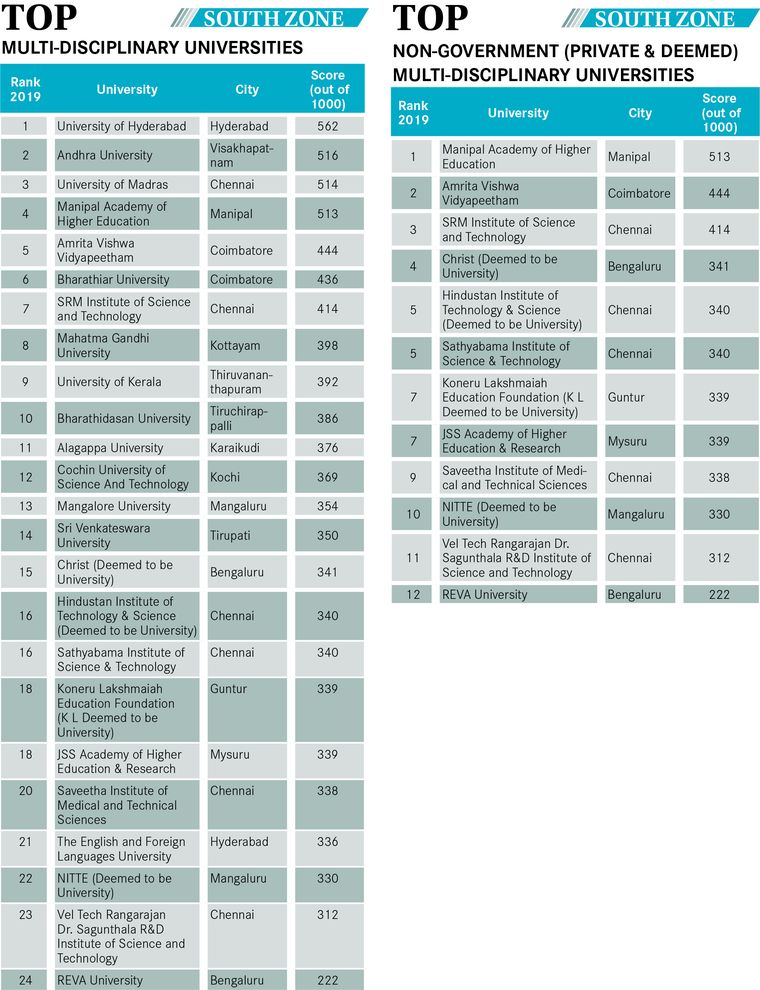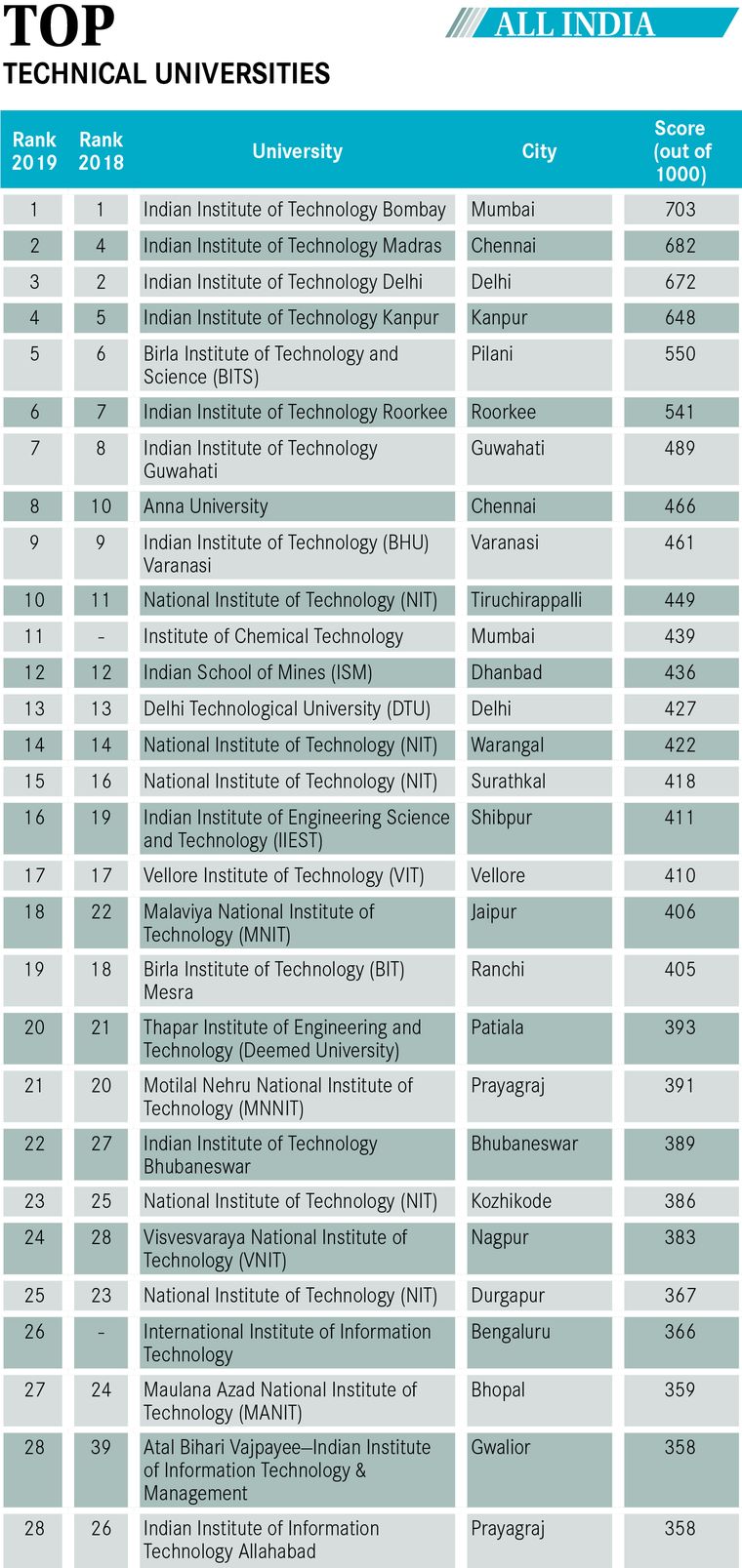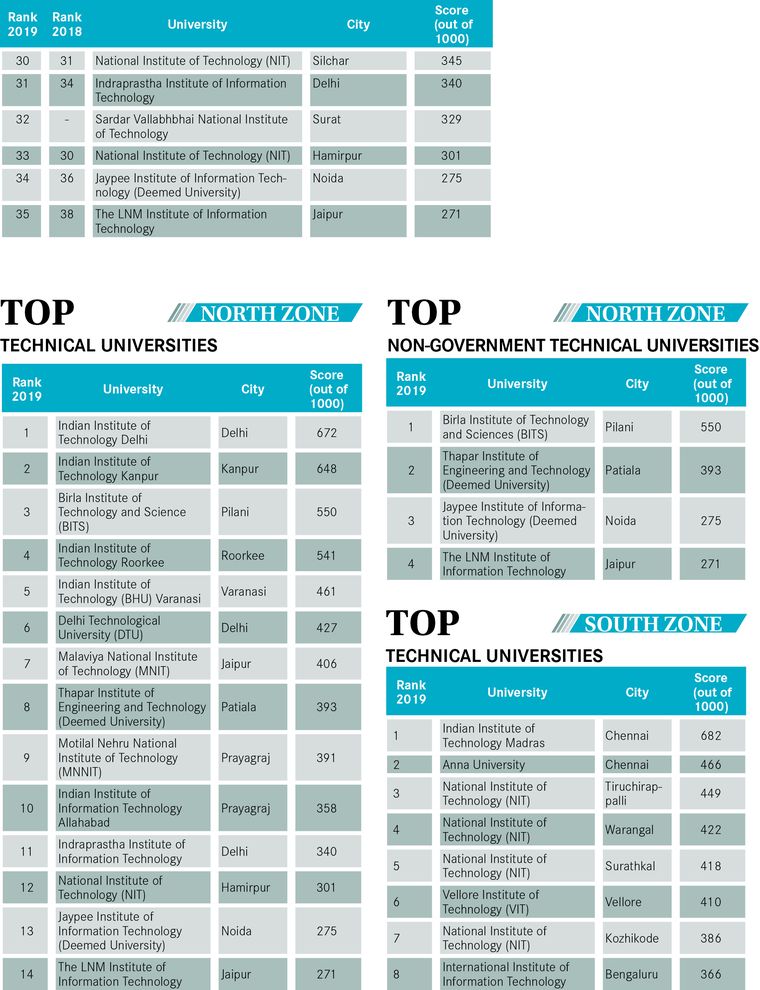THE WEEK-HANSA RESEARCH BEST UNIVERSITIES SURVEY 2019
Feisty and effervescent, Uditi Chandrashekhar is the kind who can enliven even the dullest gathering. The 17-year-old is crystal clear about what she wants from her university. "What I am looking for is a small campus where there is a lot of emphasis on students learning the skills around, and thus being able to decide their own course, while teachers take up the role of mentors and facilitators," said the class 12 student from Mahindra United World College in Paud, Maharashtra. "The strength of the university should ideally lie in inculcating diverse aspects of creativity." Uditi loves the UWC campus that is spread over a 175-acre biodiversity reserve.
Seventeen-year-olds like Uditi are particular about what they want in life. However, university hunting can sometimes rattle even the brightest. India has a problem of plenty in higher education, in terms of the number of colleges and courses. The sheer number of applicants make competitive exams tougher. Take the case of the engineering entrance exam JEE, considered one of the toughest in the world. Around 10 lakh applicants vie for just 10,500 Indian Institute of Technology (IIT) seats.
Nonetheless, getting into an IIT is worth the trouble, said Varun Mittal, 24, who graduated in mechanical engineering from IIT Bombay, which is the number-one ranked technical university in THE WEEK-Hansa Best Universities Survey 2019. "Most parents and students in India continue to dream of it—some for the opportunities at IITB, some for the life it promises after graduation and some for the very love of engineering and sciences," said Mittal, who is assistant manager at ITC, Bengaluru.
"The first year at IITB was awesome. While subjects like quantum physics, electricity and magnetism were as intriguing as expected, life apart from academics offered so much," said Mittal. There were technical, cultural and sports events, which included international competitions with participants from the world's best universities that kept them engaged. "Throughout one's time at IITB, the experiences teach you a lot. It does not matter what you do there, as long as there is some constructive use of time. There are so many things on offer, and so much to choose from. Whatever you take up based on your interests will help you learn and grow."
The professors at IITB do not want students to limit their focus on just academics. "IITB helps you grow as an individual. You could have a go at dancing, acting, organising, designing, research and development and sports. Most of these opportunities let you operate or compete at large scales with the very best," said Mittal.
Jawaharlal Nehru University, which tops the multi-disciplinary category of THE WEEK-Hansa Research Best University Survey 2019, boasts a vibrant intellectual atmosphere, characterised by a culture of debates and differences. The international exposure the Central university offers stands students in good stead when they enter the job market. "We have students from around the country and abroad," said G.J.V. Prasad, professor of English. "We have a truly inclusive campus, and the interaction between students and faculty from varied social, economic and regional backgrounds makes for a healthy, intellectually stimulating and progressive atmosphere, and anyone who spends time in JNU benefits from it," he added.
Nagarajan V., a 21-year-old from Bengaluru, has been chasing his dream of designing and developing hydrogen-powered vehicles. He enjoys every bit of his journey, and stresses on the benefits of being clear about one's career goals. Nagarajan studies mechanical engineering with a specialisation in energy engineering at the Vellore Institute of Technology. "The course makes a lot of sense to me. Renewable energy is the way forward," he said. "The syllabus is pretty interesting. It covers topics like alternative fuels, fuel cells and wind energy engineering."
Universities are increasingly realising the importance of experiential learning. Across streams, students are encouraged to get their hands dirty to learn new things.
Postgraduate and PhD students at Deccan College Post Graduate and Research Institute, Pune, have learnt more from the burial pits of Farmana in Haryana than from their textbooks. They go on field trips to the Harappan sites, guided by vice chancellor Dr Vasant Shinde, an internationally renowed archaeologist. Shinde walks them through history and shows them how the Harappans evolved from hunter-gatherers to settlers.
Shinde said that classroom teaching should be supplemented with experiential learning, because what is taught in classrooms could be forgotten in a week or two. "Teachers should go beyond classrooms and textbooks and get students interested in the subject," he said.
The University Grants Commission has directed universities to incorporate experiential and outcome-based learning into their curriculum. "With this objective in mind, the UGC is introducing a new model syllabus for every subject. I have been given the responsibility of developing the syllabus for archaeology," said Shinde. "[In Archaeology,] unless students get hands-on experience and handle the specimens, they will not be able to understand the subject."
Deccan College, a deemed university since 1994, has laboratories and museums that house artefacts and specimens that date back to the Stone Age. "When you want to teach about a particular site, we show them actual evidence gathered from there," said Shinde.
Shinde had a 200-member audience under his spell when he recently delivered a talk at the National Gallery of Modern Art, Bengaluru, on the Indus valley civilisation and the Rakhigarhi site. "The extraction of DNA from the skeletons of Rakhigarhi was an important breakthrough. That gave us scientific evidence about who the Harappan people were and their relation with the contemporary population," he said, adding that eager students have been part of all his excavation projects.
Field trips to Farmana give students greater insights into the lives of Harappans. "Most of the data we have hitherto had been on Harappan cities. The history of the Harappan civilisation gets unfolded through its cities. But sites like Farmana tell a different story. The small settlements in Farmana played a key role in their socio-economic organisations. Food grain and other essential goods were supplied to Rakhigarhi by these small settlements. That was not understood earlier," said Shinde.
Private universities in India bridge the demand-supply gap for quality education, offering an array of professional and non-professional courses. Lovely Professional University (LPU) in Phagwara, Punjab, is home to 25,000 students. Founded in 2005, it has a picturesque campus spread over 600 acres.
LPU has been a breeding ground for innovations. FoodPi, a device recently developed by LPU students, can be a real game changer. It allows you to find out how fresh the food kept in your refrigerator is. Determining whether the meat is edible or rotten can be tricky. With FoodPi, the user gets notifications on his or her phone in the form of graphs and percentages of decay.
The device is installed with the exhaust inlet and light system of the refrigerator. The requirement is that it should be a smart refrigerator with internet connectivity. FoodPi identifies the concentration of gases released from food using an electrochemical sensor. It uses Internet of Things and Wireless Sensor Networds-integrated architecture to provide the user access to the results.
According to Tanmay Baranwal, project lead for FoodPi: "A lot of people believe that once they keep the food in their refrigerators, it remains safe to consume even after several days. This is not true. While the refrigerator reduces the rate of decay, the food may still get spoilt. We created FoodPi to help people track food decay in their refrigerators." The device that costs between Rs 20,000 and Rs 25,000 can be used for commercial purposes as well. The university has filed for patent for the device.
LPU encourages its students to develop socially useful projects. The 1,520 projects showcased by its students at the Annual Graduation Project Expo 2019 included an automatic headlight dimmer, oxygen extracted from algae, machine learning-based driverless cars and a drone called Flying Farmer that can be used for crop surveillance.
"By implementing emerging trends of the education sector in the university curriculum and working closely with the industry for transforming students into the best employable human resource, LPU has established its name among the best universities of the country," said Ashok Mittal, chancellor, Lovely Professional University. "We have collaborations with top industries, where students work on live projects in state-of-the-art laboratories set at the campus. Minister of Human Resourse Development Prakash Javadekar recognised the innovative abilities of our students, and took a ride on our solar-powered driverless bus. Our students are in the competitive race with the most technologically aware people across the globe and are excelling. So, every year, LPU sees enhanced placement of its students, even in developed countries."
Aditya Berlia, pro-chancellor, Apeejay Stya University, said that the 21st century has led universities to rethink their role in society and the manner in which they teach, research and define learning. "At the macro level, three trends are becoming the hallmarks of those who are rapidly evolving. The first is a hyper-focus on students. Curricula are now tailored to individual students instead of mass-produced education. The second is a focus on five-year and longer outcomes. This is shaking up the erstwhile established universities which never had to earlier prove their worth in longer terms or even outcomes. The last and most important is the realisation that getting a PhD does not automatically make someone a great teacher. There is now a shift towards teacher training even at the highest levels with an acknowledgement there needs to be a higher benchmark for teaching skills."
Private universities help students develop the right attitude, besides enhancing their knowledge level and skills, said Dr Fr Abraham V.M., vice chancellor, Christ University, Bengaluru. "As a university committed to societal development, our focus has always been on nurturing individuals who are socially conscious and competent. Being innovative in approach, we are ahead in terms of programmes offered, pedagogy adopted and infrastructure provided. And because we emphasise on the development of key skills— communication, critical thinking, problem-solving and leadership—our graduates remain proficient in their chosen fields."
India has around 900 universities. Dr H. Vinod Bhat, vice chancellor, Manipal Academy of Higher Education, Manipal, predicts that the number of universities could go up to roughly 1,500 in the next three years, 75 per cent of which will be in the private sector. Bhat is concerned about the perils of such proliferation in India. "I am afraid the quality of higher education will be lacking among Indian private higher education players," he said. "This is because these universities are still young and need time to grow."
What is even more worrisome is the job scenario in India. Universities churn out more and more graduates every year, adding to the country's unemployment woes. In Uttar Pradesh, 3,700 PhD holders, 28,000 postgraduates and 50,000 graduates had applied for 62 posts of peon-messenger in UP police in 2018. The minimum eligibility for the job was class five.
According to the Skill India report 2018, only 47.38 per cent of Indian graduates are employable. Universities can play a crucial role in addressing this issue.
"We should strive to make every graduate employable. This can be achieved by imparting work skills through internships in the industry," said Bhartendu K. Singh, physics professor at the Banaras Hindu University. "Academic institutions should also facilitate continued collaborations with employers and take note of the changing needs of businesses." He said this is a win-win situation as graduates equipped with the right skills can drive productivity in the workplace. "Creating opportunities to collaborate with interdisciplinary, cross-cultural teams to solve complex problems is equally important," said Singh, who is also chairman of the internal quality assurance cell at the Institute of Science, BHU.
Over half of India's employees are unhappy at work, according to a 2017 survey. Savera Aranya, 17, from Chandigarh attributes it to students being goaded or herded along expected lines, ending up in jobs they do not like.
More universities are giving students flexibility to choose subjects and courses that suit their interests. Satnam Singh Sandhu, chancellor of Chandigarh University said that the university has aligned its academic learning model to meet the aspirations of today’s youth. "Be it campus placements or to become an entrepreneur, be it research and innovation or availing international avenues, CU offers every student a platform where they can opt for a career of their choice. The success of any academic institution is that it is able to offer successful careers and not just degrees to its students. CU is setting new benchmarks by providing freedom to every student to choose his or her career path."
Mody University in Lakshmangarh, Rajasthan, is a women's university that enables students to design their own courses and encourages experiential learning. "We believe that knowledge does not come from books alone," said Dr M. Venu Gopala Rao, director. "What makes our programme structure uniquely different from other universities is its innovative student-friendly course selection where students can design their own course, maintaining the sanctity and authenticity of the UGC and other statutory bodies, with choices like sports, yoga, life skills, music and fine arts. It is because of our continuous efforts to proliferate excellence in women education in India, that various institutions have recognised us as the best women’s university in India."
"What we need is not evolution but a revolution in education," said Sir Ken Robinson, British author and adviser on education in the arts to the British government. He was speaking at a TED Talks event. "I think we are obsessed with getting people to college. I do not mean you should not go, but not everybody needs to go or go now. Maybe they go later, not right away." Robinson quoted chef Jamie Oliver, saying that our education systems seem to be based on the model of fast food, where everything is standardised. "It is impoverishing our spirits and energies as much as fast food is depleting our physical bodies," he said. Food for thought for our education institutions.
METHODOLOGY
THE WEEK-Hansa Research Best University Survey 2019 provides insight into the hierarchy of multi-disciplinary and technical universities in the country. Universities recognised by the UGC, offering full-time postgraduate courses in at least two disciplines and having graduated at least three batches of students for postgraduate programmes were eligible.
A primary survey was conducted with 231 academic experts, spread across 18 cities. They were asked to nominate and rank the top 20 universities in India. Of the 231 interviews, eight were qualitative, to get an in-depth understanding of the reasons for the rankings.
Perceptual score for a university was calculated based on the number of nominations received and the actual ranks given to the university.
For factual data collection, a dedicated website was created and the link was sent to more than 570 universities. Advertisements were also published in multiple issues of THE WEEK, inviting universities to participate. Fifty-six universities responded with their information within the stipulated time.
Factual score was calculated using the information collected from universities and other secondary sources on age and accreditation, infrastructure and other facilities, faculty, research and academics, student intake and industry exposure and placements (only for technical universities).
Final score = Perceptual score (out of 400) + factual score (out of 600)
Some universities could not respond to the survey. For these universities, the final score was derived by combining the perceptual score with an interpolated factual score based on their position on the list.



